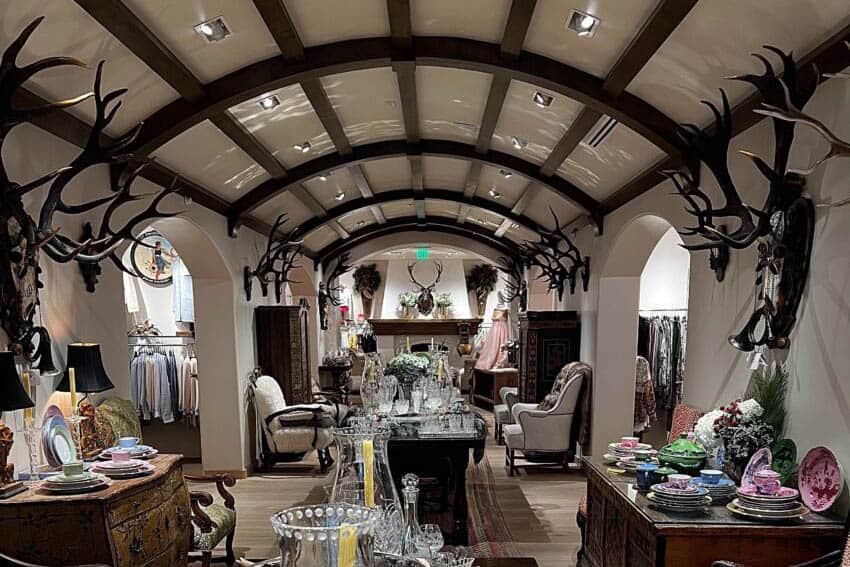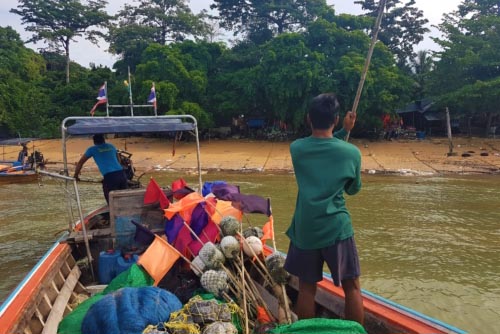Ayutthaya boast history, culture, and charm
By Sarah Cavicchi
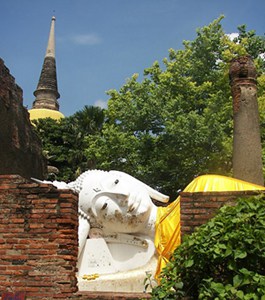
After exploring Thailand’s bustling cosmopolitan center of Krung Thep (that’s Bangkok to you and me), I was ready to go on later excursions to get a complete picture of Thailand.
So when our tour guide gave us a history lesson on Ayutthaya as we settled in the van first thing in the morning, I had an internal geek out and began furiously taking notes.
I’ve always really enjoyed ruins and other crumbling buildings wherever I roam, despite some experienced travelers’ opinions and upturned noses to sightseeing.
There’s something indescribable about ancient sites that I love, almost as if I can feel the history and the energy that once took place on what is now just a pile of rocks. I always have an unexplained need to touch the stones, picnic on the grassy knolls, and try to sit for a short moment to let the inspirational energy flow through me.
But maybe its more of my love for history that sparks my interest — it’s always so invigorating to explore crumbling cities and think about how just a few hundred years ago, that pile of rock was the cornerstone to a rich man’s house or that flat stone paved a bustling marketplace in a metropolis of trade and war.
So the ruins of Ayutthaya really filled the void in that regard. There are more than 30 separate parts of the old city to explore, all within a four-mile radius of one other, so if historical travel is your thing, the Ayutthaya ruins can keep you busy for quite a while.
But First, Some History
Founded around 1350 A.D., the city was the country of Siam’s second capital, replacing the nearby abandoned Sukhothai. Because of its location between China and India, it became a huge trading center for Asia and the rest of the world. Foreign settlements with traders from as far as the Netherlands and France were constructed outside the city limits.

As the city’s influence and trading reputation grew, so did Ayuthaya’s list of enemies. Many wars between Burma, Cambodia, and China erupted, and although Ayutthaya did lose occasionally (to Burma twice in the 1500’s for example) it was never overrun or occupied, just made to pay financial tributes.
But in 1797, everything changed and the bustling metropolis of Ayutthaya was destroyed along with much of the rest of Siam as part of the Great War with Burma. And so the great city of Ayutthaya became a ruin.
Bustling Temple
Our first introduction to the ruins was Wat Yai Chaimongkon, a surprisingly active temple. Local worshipers gathered around more modern architectural additions to perform blessings by dipping unopened lotus flowers in water and sprinkling their foreheads.
They offer up pieces of gold leaf to small statues depicting Buddha sitting on Naga, the seven-headed serpent. The smell of incense wafts throughout the grounds every now and then, reminding me that this is still very much a religious site.
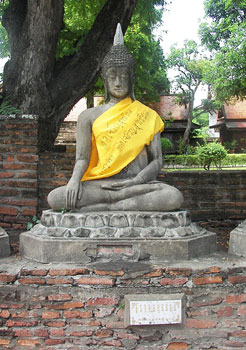
The Buddha statues here are still well maintained by their local families, fully intact, and draped in saffron robes, sometimes including black writings in Thai indicating exactly which family member donated what.
The same fabric decorates lots of different structures around Wat Yai Chaimongkon. The reclining Buddha greets visitors at the gate and wears his saffron surrounded by what’s left of his old wiharn, a housing structure built for important Buddhas where worshipers are welcome to come and pray.
The giant chedi, a tall spiral that contains unknown ashes looms from the courtyard reminding all of the temple’s previous incarnation of grandeur.
Because of this saffron dangling from most of Wat’s older structures and the active worshipers wandering about, Wat Yai Chaimongkon was very photogenic and well worth the 20-baht entry fee. And although it didn’t give off the old energy of other locales, its activity among the ruins showcases the Thais’ ongoing love for their history and traditions.
Ghost Town
Next we switched gears a bit and visited a much more deconstructed temple called Wat Phra Mahathat. Sacked quite thoroughly by the Burmese, most of the chedis and other structures are toppled or on their way down.
There were no complete buildings or walls to be seen, no active groups of locals praying, no incense, just an eery and quiet calm atmosphere. Bodhi trees and other greenery crept into certain areas, providing bits of shade on one side, while the chedis disintegrate out in the sun.
Stealing Pieces of Buddha
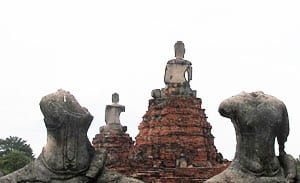
Almost every depiction of Buddha that was left has been vandalized in some way, making me feel like an intruder in a ghost town. Our tour guide explained that pieces of Buddhist statues are such a popular type of art for tourists that the locals have come in to tear off what they can for profit, the prime seller being the head.
And this headless theme continues through most of the ruins of Ayutthaya, giving a new perspective to the ever popular eastern art pieces that I’ve seen replicated in plastic imitations at the local mega mart.
There is one ray of hope in this otherwise sad ruin. One of the Buddha statue’s head is beautifully framed in the roots of a bodhi tree, the same tree that Buddha sat under when he obtained enlightenment.
Apparently, this Buddha statue, having been dismembered, was forgotten, and his head was hidden from the local ransackers. The bodhi tree’s roots overgrew what was left of the sculpture, framing it in such a way to make it look like Buddha’s face is popping out of the now large tree.
The beautiful depiction is seen as a miracle and serves as a shrine to the locals, decorated every now and then with saffron robes and reserved as a quiet place to come and pray.
Bowing Down
Our final stop was Wat Chaiwatthanaram, the oldest temple of the day, and the most dramatic in scope. It was built in 1630 A.D. by King Prasat Thong in memory of his mother.
Distinctly different from the previous two temples, Wat Chaiwatthanaram was modeled after the famous Angkor Wat, thus it was built in the Khmer or Cambodian in style rather than in the more Siamese/Thai style of most of Ayutthaya.
Until the Burmese came through, the structure was a sacred place for the royal family, as the cremation site for princes and princesses, and the final resting place for King Prasat Thong’s mother. The Cambodian structure has held up quite well. Despite losing its roof and outside walls to the elements and vandalism by the ransackers, this temple was the most unified structure we’d seen all day.
Chaiwatthanaram is very sparse, without any sort of shade or greenery except the well-kept expanse of lawn outside the outer walls, so the sun did beat down pretty fiercely.
Maybe this was why we saw very few people, even though it’s supposedly very famous and favored by tourists. This temple was rather uncrowded as we explored the structure.
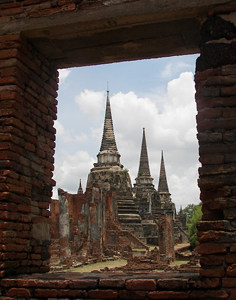
The main passage is a rectangular walkway lined with eight small chedi-shaped chapels dotted along and 120 Buddha statues, unfortunately in the same headless fashion. There are also larger chedis, some open to the public, that house the ashes of the king’s mother and other important figures.
The view from the top of one of larger chedis was gorgeous, but the climb was a bit of a treacherous venture. Climbing up the steps isn’t really the problem, but because they’re so steep, climbing down becomes a project.
Our tour guide explained the reasoning behind this construction as a way to adjust your posture, to make sure you’re entering and exiting the sacred structure showing your reverence in the forced bow. Going down, not only did I take on this reverent posture, I absorbed fear.
My eyes were downcast, searching the steps I couldn’t see, my knees shook nervously, afraid I was going to miss a place where the step had crumbled away, my hand extended out to grasp the railing for dear life. But in the end, I survived, and felt fantastically glad I didn’t just wait in the air-conditioned van.
Visiting Ayutthaya:
Ayutthaya is about 85 km north of Bangkok, generally an hour to an hour and a half journey. Because of Thailand’s unique driving style, a rental car is not recommended.
But the Northern line train at Hua Lumphong Station will get you to Ayutthaya in an hour and a half, running every hour from 4:20 am to 10:00 pm daily. Fare runs between 15-66 Baht.
To get around the ruins, there are a few options. Bikes are available for rental at most guesthouses for 40-50 Baht a day. Walking is also possible, but not recommended in the rainy season.
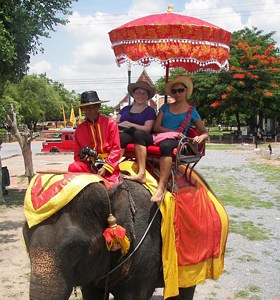
Tuk-tuks are everywhere, and if you want to spend the day going through the ruins, it is possible to negotiate with a driver to charter by the hour (150 Baht) or by the day (500 Baht).
Most accommodations in the area are off island, further away from the ruins, but there’s a cluster of guesthouses and bed and breakfast inns within walking distance to the island.
Tripadvisor favorite Prom Tong Mansion has a decent location. Three kilometers from the train station and averaging between 400-1,000 Baht per night, Prom Tong is pretty affordable and a great starting point for any Ayutthaya excursion.
The Baan Lotus Guesthouse, although basic, is also quite close to the action at 20 Pa-Maphrao Road and will run you between 450-650 Baht per night.
One baht is equivalent to about three US cents.
If you’re overwhelmed by the expanse of ruins, start your day at the Ayutthaya Historical Study Centre on Rochana Road. Open 9am-4:30 pm, they specialize in Ayutthaya’s capital city period and can help you pick out your ruins map with the historical context in mind.
Further Information:
Baan Lotus Guest House
Ayutthaya: Thailand Tourism Board
- GoNOMAD Reviews of New Travel Products - June 1, 2012
- Lake Lovers Have a Home at Lakelubbers.com - August 1, 2010
- Blue Highways: An American Road-Trip Classic - August 1, 2010



